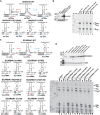Guide RNA acrobatics: positioning consecutive uridines for pseudouridylation by H/ACA pseudouridylation loops with dual guide capacity
- PMID: 34916304
- PMCID: PMC8763049
- DOI: 10.1101/gad.349072.121
Guide RNA acrobatics: positioning consecutive uridines for pseudouridylation by H/ACA pseudouridylation loops with dual guide capacity
Abstract
Site-specific pseudouridylation of human ribosomal and spliceosomal RNAs is directed by H/ACA guide RNAs composed of two hairpins carrying internal pseudouridylation guide loops. The distal "antisense" sequences of the pseudouridylation loop base-pair with the target RNA to position two unpaired target nucleotides 5'-UN-3', including the 5' substrate U, under the base of the distal stem topping the guide loop. Therefore, each pseudouridylation loop is expected to direct synthesis of a single pseudouridine (Ψ) in the target sequence. However, in this study, genetic depletion and restoration and RNA mutational analyses demonstrate that at least four human H/ACA RNAs (SNORA53, SNORA57, SCARNA8, and SCARNA1) carry pseudouridylation loops supporting efficient and specific synthesis of two consecutive pseudouridines (ΨΨ or ΨNΨ) in the 28S (Ψ3747/Ψ3749), 18S (Ψ1045/Ψ1046), and U2 (Ψ43/Ψ44 and Ψ89/Ψ91) RNAs, respectively. In order to position two substrate Us for pseudouridylation, the dual guide loops form alternative base-pairing interactions with their target RNAs. This remarkable structural flexibility of dual pseudouridylation loops provides an unexpected versatility for RNA-directed pseudouridylation without compromising its efficiency and accuracy. Besides supporting synthesis of at least 6% of human ribosomal and spliceosomal Ψs, evidence indicates that dual pseudouridylation loops also participate in pseudouridylation of yeast and archaeal rRNAs.
Keywords: RNA-guided RNA modification; RNA–RNA interaction; box H/ACA RNAs; guide RNA acrobatics; pseudouridine; pseudouridylation.
© 2022 Jády et al.; Published by Cold Spring Harbor Laboratory Press.
Figures







Comment in
-
Guide RNA acrobatics: the one-for-two shuffle.Genes Dev. 2022 Jan 1;36(1-2):1-3. doi: 10.1101/gad.349285.121. Genes Dev. 2022. PMID: 35022325 Free PMC article.
References
-
- Bakin AV, Ofengand J. 1998. Mapping of pseudouridine residues in RNA to nucleotide resolution. Methods Mol Biol 77: 297–309. - PubMed
MeSH terms
Substances
LinkOut - more resources
Full Text Sources
